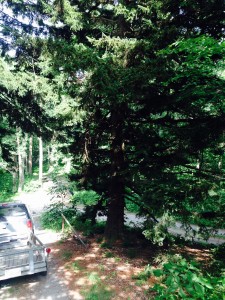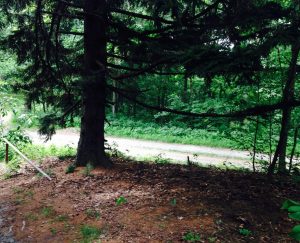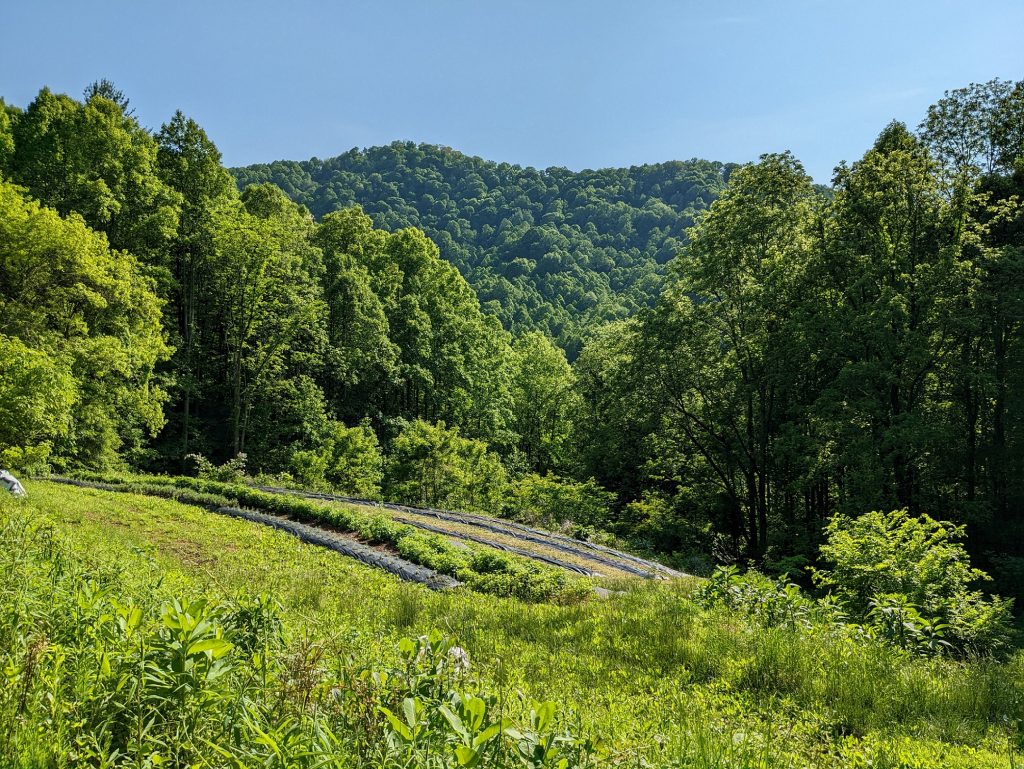Wild-Crafting
Our wild-harvest practices seek to minimize impact on the forest (and to improve forest health) through the use of intelligent and sustainable pruning. Bottom branches of trees are carefully pruned, leaving the middle layers and canopy intact. This ensures the tree will have plenty of branches left to thrive while providing the benefits of increased airflow and light for saplings (while removing invasives) at the forest floor.


Some of our species are not common at lower elevations so we work with the U.S. Forest Service and acquire permits for harvests in National Forests. The USFS provides guidance towards a healthy intersection between species preservation, active forest management, wild-fire mitigation and sustainable harvesting. The Spruce stand in the above photos was very tangibly saved from a severe forest fire that swept right over this peak the year following our harvest!
In the following video, Ian discusses some of the sustainability issues with harvesting for essential oil production and ways that we work to meet the ecosystems’ needs first.
Seasonally, we are blessed with perennial and annual “weeds” such as Goldenrod, Mugwort, Yarrow and many others. For these batches there is less of a sustainability concern as populations are prolific but we still make sure to leave dispersed stands of flowers for pollinators and genetic diversity. Harvesting for these seasonal batches is a labor-intensive process so we have only produced a few to date, but we are working hard to do more of these very special distillations. If a species is endangered or under threat, we will not wild-harvest it (such as the Eastern Hemlock tree, threatened by the Hemlock Woolly Adelgid).
Waste as Food
Wherever possible, we pursue the Cradle to Cradle principal; “waste” from one system serves as feedstock for another system. We source most of our conifer batches from storm-damaged trees, no-spray landscaping trimmings or existing forest/land-clearing and development projects. Our Ginger essential oil is made from “waste” organic Ginger root pulp that was juiced by another business. All of our spent distillation materials are composted or used as mulch.
Our Forest Farm
Our distillery is on a remote 45-acre forest farm at the back of a cove along the Big Laurel Creek in Madison County, NC. This wilderness has incredible biodiversity, 3,400′ peaks and many native species that are rare to find in significant populations elsewhere. We have a few acres of terraced field that we organically cultivate with various Basils, Lemon Balm and Lavender (we hope to have Lavender oil available in July 2023). The terraced garden sits at 2,800′ elevation and is drip-irrigated with the abundant spring water that constantly spills from the Walnut Mountains ridgeline. Additionally, populations of unique herbs/shrubs are being encouraged/expanded in a wild-simulated manner. These currently include: Shiso/Perrilla, Tagetes minuta (Mexican Marigold), Catnip, Spicebush, Sweetshrub and Chocolate Mint.
 For our cultivated rows, we use a minimal-till approach. Initially, the ground is tilled to make a new row and organic potting soil is added to each plant site. Every following year, we simply add plant-based compost made from our spent distillation materials. The diverse combination of plant types that we work with (from starch-rich ginger root to shredded conifer branches) creates a nice, fluffy compost that aptly complements our dense clay and quartz subsoil. The distillation process essentially cooks many of the nutrients out of our compost, but that works out well since the clay-based subsoil is mineral-rich and the forest topsoil is nutrient-rich.
For our cultivated rows, we use a minimal-till approach. Initially, the ground is tilled to make a new row and organic potting soil is added to each plant site. Every following year, we simply add plant-based compost made from our spent distillation materials. The diverse combination of plant types that we work with (from starch-rich ginger root to shredded conifer branches) creates a nice, fluffy compost that aptly complements our dense clay and quartz subsoil. The distillation process essentially cooks many of the nutrients out of our compost, but that works out well since the clay-based subsoil is mineral-rich and the forest topsoil is nutrient-rich.
We do anticipate the eventual need to add nitrogen to our cultivation rows. Our long-term vision for the forest farm includes a few minimal-impact development sites. If a new section of forest is cleared/developed, some topsoil will be harvested from the site and used as cultivation soil amendment.